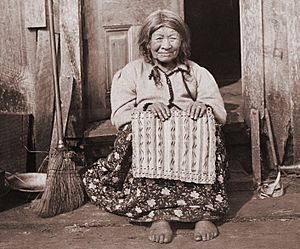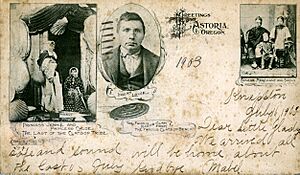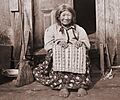Tsin-is-tum facts for kids
Tsin-is-tum, also known as Jennie Michel (born around 1814, died 1905), was a Native American woman from the Clatsop tribe. She lived on the Pacific Coast of Oregon. Tsin-is-tum was known for sharing the stories and history of her people. People called her the "Last of the Clatsops" when she passed away in 1905.
She was often photographed and helped historians learn about the native peoples of the Pacific Northwest region of the United States. Tsin-is-tum shared stories from her family about meeting members of the Lewis and Clark Expedition. This famous expedition visited the area in the winter of 1805-1806. Her help even allowed historians to find the old salt-making sites used by Lewis and Clark.
Contents
Who Was Tsin-is-tum?
Tsin-is-tum, also known as Jennie Michel, was a Clatsop woman. She was born around 1814 in what is now Oregon. Her mother, Wah-ne-ask, actually saw the Lewis and Clark Expedition when they explored the Pacific Northwest in 1805 and 1806. We don't know her father's name. He died when his village was attacked by a warship, likely in 1829.
Sharing Clatsop Stories
Historians from the Oregon Historical Society saw Tsin-is-tum as an important source of information. She knew many traditional stories of the Clatsop people. She also shared oral history about the Lewis and Clark Expedition. Her family members had met the explorers, Meriwether Lewis and William Clark, during their stay in Oregon.
Tsin-is-tum learned from her mother's memories. She also heard from her uncle, Ka-ta-ta. He told her about hunting elk with the explorers. When Lewis and Clark arrived, the Clatsop people's population was very small, maybe only 200 people. Many had died in the late 1700s from new diseases brought by outsiders.
Tsin-is-tum's Family Life
Tsin-is-tum first married Wah-tat-kum, who was the last chief of the Nehalem people. They lived along the Oregon coast between the Columbia and Nehalem rivers. After his death, she married again. Her second husband was Michel Martineaux, a French-Canadian man. He was a retired steamboat captain. Her other name, Jennie Michel, came from this marriage. They lived in the area of Seaside, Oregon.
Helping Historians Find Salt Works
In June 1900, Tsin-is-tum gave a statement to the Oregon Historical Society. She told her life story. She also helped them find the exact spot where the Lewis and Clark party made salt. They had used this site during their winter stay in Oregon in 1805-1806. At that time, people believed she was one of only three full-blooded Clatsops still alive.
Tsin-is-tum passed away in March 1905. She was about 89 years old. When she died, many called her "the last of the Clatsops." This meant she was likely the last full-blooded member of her Native American tribe.
Images for kids





